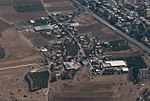Tiberias Football Stadium
Football venues in IsraelHigh-tech architectureMulti-purpose stadiums in IsraelSport in TiberiasSports venues in Northern District (Israel) ... and 1 more
Stadiums under construction

Tiberias Municipal Stadium (Hebrew: האצטדיון העירוני של טבריה, HaItztadion HaIroni Shel Tverya), is a football stadium currently being built in Tiberias for Ironi Tiberias F.C., the football team of the town, and will replace the old stadium located downtown. Once completed, the new stadium will include 7,554 seats. It is located at the southern entrance to the city, near the junction of Poriya Hospital as a part of a sports complex also including a multi-purpose 2,500-seat sports hall, a training field and a swimming pool. As of late 2020, the project was frozen due to lack of funds.
Excerpt from the Wikipedia article Tiberias Football Stadium (License: CC BY-SA 3.0, Authors, Images).Tiberias Football Stadium
768, Tiberias Tveria Illit
Geographical coordinates (GPS) Address Nearby Places Show on map
Geographical coordinates (GPS)
| Latitude | Longitude |
|---|---|
| N 32.7679 ° | E 35.51415 ° |
Address
768
1427943 Tiberias, Tveria Illit
North District, Israel
Open on Google Maps







